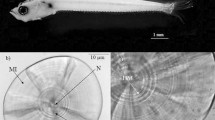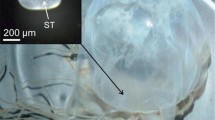Abstract
We observed that paired winter flounder (Pseudopleuronectes americanus) sagittae are not morphologically or chemically identical. Statistically significant (p < 0.05) chemical asymmetry was detected between the sagittae in five of eight elements (with three other elements, Sr, I, and Sn not statistically different). The blind-side otolith exhibited higher mean concentrations of Ba, Mn, Mg, Cu, and Zn trace elements than the eyed-side otolith. These asymmetries may be due to blind-side otoliths absorbing higher concentrations of transitional elements, partly as a result of environmental heterogeneity caused by redox reactions emanating from the sediments. Metamorphic transformation and the subsequent shift to the benthos by fully formed fish may also account for element concentration levels that were significantly different between juveniles and both sub-adults and adults. Our results also suggest that chemical uptake in a pair of winter flounder sagittae is an asynchronous event, and that each otolith potentially records the chemical history of its environment independent of the other. The physiological pathway for entry into winter flounder otoliths is uncertain and warrants further testing. Overall, our results have implications for other flatfish genera as well, and demonstrate the need for standardization of methodology when conducting otolith chemistry on flatfishes.






Similar content being viewed by others
References
Adams DA, O’Connor JS, Weisberg S.B. (1998) Final report sediment quality of the NY/N60J Harbor system: An Investigation under the Regional Environmental Monitoring and Assessment Program (R-EMAP) EPA902-R-98–001.
Arslan Z, Secor DH (2005) Analysis of trace transition elements and heavy metals in fish otoliths as tracers of habitat use by American eels in the Hudson river estuary. Estuaries 28:382–393
Baden SP, Eriksson SP (2006) Roles, routs, and effects of manganese in crustaceans. Oceanogr Mar Bio Ann Rev 44:61–83
Barbee N, Grieg A, Swearer SE (2013) Validating the use of embryonic fish otoliths as recroders of sublethal exposure to copper in marine sediments. Environ Pollut 178:441–446
Brazner JC, Camapan SE, Tanner DK (2004) Habitat fingerprints for lake superior coastal wetlands derived from elemental analysis of yellow perch otoliths. Trans Amer Fish Soc 133:69–704
Brown JA (2006) Using the chemical composition of otoliths to evaluate the nursery role of estuaries for English sole Pleuronectes vetulus populations. Mar Ecol Prog Ser 306:269–281
Calvert SE, Pedersen TF (1993) Geochemistry of recent oxic and anoxic marine sediments: implications for a geological record. Mar Geol 113:67–88
Campana SE (1999) Chemistry and composition of fish otoliths: pathways, mechanisms and applications. Mar Ecol Prog Ser 188:263–297
Campana SE, Nielson J (1985) Microstructure of fish otoliths. Can J Fish Aquat Sci 42:1014–1032
Collette BB, Klein-McPhee G (2002) Bigelow and Schroeder’s fishes of the gulf of Maine, 3rd edit. Smithsonian Institution Press, Washington, USA and London, UK
de Pontual H, Lagardère F, Amara R, Bohn M, Ogor A (2003) Influence of ontogenetic and environmental changes in the otolith microchemistry of juvenile sole (Solea solea). J Sea Res 50:199–211
de Pontual H, Lagardère F, Troadec H, Batel A, Désaunay Y, Koutsikopoulos C (2000) Otoliths imprinting of sole (Solea solea) from the bay of Biscay: a tool to disciminate individuals from nursery Origins? Oceanol Acta 23:497–513
Elsdon TS, Gillanders BM (2004) Fish otolith chemistry influenced by exposure to multiple envioronmental variables. J Exp Mar Bio Eco 313:269–284
Elsdon TS, Wells BK, Campana SE, et al. (2008) Otolith chemistry to describe movements and life-history parameters of fishes: hypotheses, assumptions, limitations, and inferences. Oceanogr Mar Bio Annu Rev 46:297–330
Gauldie RW (1996) Effects of temperature and vaterite replacement on the chemistry of metal ions in the otoliths of Oncorhynchus tshawytscha. Can J Fish Aquat Sci 53:2015–2026
Geffen AJ, Pearce NJG, Perkins WT (1998) Metal concentrations in fish otoliths in relation to body composition after laboratory exposure to mercury and lead. Mar Ecol Prog Ser 165:235–245
Hamer PA, Jenkins GP (2007) Comparison of spatial variation in otolith chemistry of two fish species and relationships with water chemistry and otolith growth. J Fish Bio 71:1035–1055
Helling K, Scherer H, Hausman S, Clark AH (2005) Otolith mass asymmetry in the utricle and saccule of flatfish. J Vest Research 15:59–64
Jearld Jr A, Sass SL, Davis MF (1993) Early growth, behavior and otolith development of the winter flounder, Pseudopleuronectes americanus. Fish B-NOAA 91:65–75
Kajajian A, Schaffler JJ, Jones CM (2013) Lack of equivalence in the elemental and stable isotope chemistry within the sagittal otolith pair of the summer flounder. ICES J Mar Sci 71:356–364
Kalish JM (1991) 13C and 18O isotopic disequilibria in fish otoliths: metabolic and kinetic effects. Mar Ecol Prog Ser 75:191–203
Kristiansen KD, Kristensen E, Jensen EMH (2002) The influence of water column hypoxia on the behavior of manganese and iron in sandy coastal marine sediment. Est Coast Shelf Sci 55:645–654
Leakey CDB, Attrill MJ, Fitzsimons MF (2009) Multi-element otolith chemistry of juvenile sole (Solea solea), whiting (Merlangius merlangus) and European seabass (Dicentrarchus labrax) in the Thames estuary and adjacent coastal regions. J Sea Res 61:268–274
Limburg KE, Olson C, Walther Y, Dale D, Slomp CP, Höie H (2011) Tracking Baltic Hypoxia and cod migration over millennia with natural tags. Proc Nat Acad Sci 81:796–825
Limburg KE, Walther BD, Lu Z, Jackman G, et al. (2015) In search of the dead zone: use of otoliths for tracking fish exposure to hypoxia. J Mar Sys 141:167–178
Loher T, Wischniowski S, Martin GB (2008) Elemental chemistry of left and right sagittal otoliths in a marine fish Hippoglossus stenolepis displaying cranial asymmetry. J Fish Bio 73:870–887
McGarigal K, Cuchman SA, Stafford SG (2000) Multivariate statistics for wildlife and ecology research. Springer-Verlag, New York
Miller MB, Clough AM, Batson JN, Vachet RW (2006) Transition metal binding to cod otolith proteins. J Exp Mar Biol Ecol 329:135–143
Milton DA, Chenery SR (2001) Sources and uptake of trace metals in otoliths of juvenile barramundi (Lates calcarifer). J Exp Mar Bio Ecol 264:47–65
Mohan J, Rahman S, Thomas P, Walther B (2014) Influence of constant and periodic experimental and hypoxic stress on Atlantic croaker otolith chemistry. Aquat Bio 20:1–11
New York City Department of Environmental Protection (NYCDEP) (2012) The state of the harbor. NY Dep Environ Prot Rep 1:1–40
Payan P, Edeyer A, Pontual H, Borelli G, Boeuf G, Mayer-Gostan N (1999) Chemical composition of saccular endolymph and otolith in fish inner ear: lack of spatial uniformity. Am J of Physiology 277:123–131
Perlmutter A (1947) The blackback flounder and its fishery in New England and New York. B Bingham Oceanogr C, Yale University 92 pgs
Platt C (1973) Central control of postural orientation in flatfish. I Postural Chang dependence Cent Neural Changes J Exp Bio 59:491–521
Rooker JR, Zdanowicz VS, Secor DH (2001) Chemistry of tuna otoliths assessment of base composition and postmortem handling effects. Mar Bio 139:35–43
Schmider E, Zeigler M, Danay E, Beyer L, Bühner M (2010) Is it really robust? Reinvestigating the robustness of ANOVA against violations of the normal distribution assumption. Meth Eur J Res Meth Behav Soc Sci 6:147–151
Schreiber AM (2006) Asymmetric craniofacial remodeling and lateralized behavior in larval flatfish. J Exp Bio 209:610–621
Sogard S (1991) Interpretation of otolith microstructure in juvenile winter flounder (Pseudopleuronectes americanus): ontogenetic development, daily increment validation, and somatic growth relationships. Can J Fish Aquat Sci 48:1862–1871
Sturrock AM, Trueman CN, Darnaude AM, Hunter E (2012) Can otolith chemistry retrospectively track migrations in fully marine fishes? J Fish Bio 81:766–795
Sturrock AM, Trueman CM, Milton JA, Waring CP, Cooper MJ, Hunter E (2014) Physiological influences can outweigh environmental signals in otolith microchemistry research. Mar Ecol Pro Ser 500:245–264
Swearer S, Forrester GE, Steele MA, Brooks AJ, Lea DW (2003) Spatio-temporal and interspecific variation in otolith trace-elemental fingerprints in a temperate estuarine fish assemblage. Estuar Coast Shelf S 56:111–1123
Takagi Y (2000) Cellular contributions to the otolith formation in teleosts: a review. Coast Mar Sci 25:16
Toole CL, Markle DF, Harris PM (1993) Relationships between otolith microsctructure, microchemistry, and early life history events in dover sole, Microstomus pacificus. Fish B-NOAA 91:732–753
Turgeon DD, O’Connor TP (1991) Long Island sound: distributions, trends and effects of chemical contamination. Estuaries 14:279–289
Vasconcelos RP, Reis-Santos P, Tanner S, Fonseca V, Latkoczy C, Günther D, Costa MJ (2007) Discriminating estuarine nurseries for five fish species through otolith elemental fingerprints. Mar Ecol Prog Ser 350:117–126
Walther BD, Kingsford MJ, O’Callaghan MD, McCulloch MT (2010) Interactive affects of ontogeny, food ration and temperature on elemental incorporation in otoliths of a coral reef fish. Environ Biol Fish 89:441–451
Acknowledgments
We thank following people and organizations for their assistance during this study: Henningson, Durham, and Richardson (HDR), the United States Army Corps of Engineers (USACE), and the New York State Dept. of Environmental Conservation (NYS DEC) for providing winter flounder samples, Deb Driscoll (SUNY ESF) for assistance with sample analysis. This work is based in part upon research conducted at the Cornell High Energy Synchrotron Source (CHESS), which is supported by the National Science Foundation and the National Institutes of Health/National Institute of General Medical Sciences under NSF award DMR-00936384. We would also like to thank the CUNY Graduate Center for making this research possible.
Author information
Authors and Affiliations
Corresponding author
Rights and permissions
About this article
Cite this article
Jackman, G., Limburg, K.E. & Waldman, J. Life on the bottom: the chemical and morphological asymmetry of winter flounder (Pseudopleuronectes americanus) sagittae. Environ Biol Fish 99, 27–38 (2016). https://doi.org/10.1007/s10641-015-0451-z
Received:
Accepted:
Published:
Issue Date:
DOI: https://doi.org/10.1007/s10641-015-0451-z




